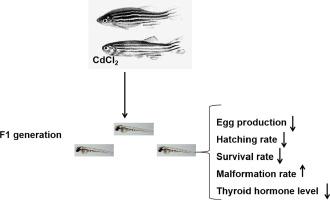当前位置:
X-MOL 学术
›
Comp. Biochem. Physiol. C Toxicol. Pharmacol.
›
论文详情
Our official English website, www.x-mol.net, welcomes your
feedback! (Note: you will need to create a separate account there.)
Parental exposure to cadmium chloride causes developmental toxicity and thyroid endocrine disruption in zebrafish offspring.
Comparative Biochemistry and Physiology C: Toxicology & Pharmacology ( IF 3.9 ) Pub Date : 2020-04-25 , DOI: 10.1016/j.cbpc.2020.108782 Jingjing Tian 1 , Jia Hu 2 , Wei He 3 , Lianqun Zhou 1 , Yinong Huang 3
Comparative Biochemistry and Physiology C: Toxicology & Pharmacology ( IF 3.9 ) Pub Date : 2020-04-25 , DOI: 10.1016/j.cbpc.2020.108782 Jingjing Tian 1 , Jia Hu 2 , Wei He 3 , Lianqun Zhou 1 , Yinong Huang 3
Affiliation

|
Cadmium is a common heavy metal pollutant. Previous studies have found that long-term cadmium exposure can cause damage to multiple organs/systems in humans and experimental animals; however, there are few studies that elucidate its effects on offspring development, discuss whether it can be transmitted to offspring from the parent, and debate whether it affects the functional development of the thyroid hormone system in offsprings. In this study, sexually mature zebrafish were exposed to different concentrations of cadmium chloride (0.01 μmol/L, 0.1 μmol/L, and 1 μmol/L) to study reproductive toxicity. It was found that parental zebrafish exposed to 1 μmol/L of cadmium chloride produced offsprings with different degrees of malformation. At 5 days post-fertilization (dpf), the levels of 3,5,3'-triiododenosine (T3) and thyroxine (T4) in the zebrafish were decreased. At 10 dpf, the T4 and T3 levels in the zebrafish of the offspring were significantly reduced. At the same time, the expression of thyroid receptor (trα and trβ) genes in five dpf larvae was significantly up-regulated in the 1 μmol/L treatment group relative to the control group. The mRNAs of thyroid hormone synthesis and metabolism-related genes (tshβ, dio1, dio2, ugt1ab, and ttr) were significantly up-regulated in the 0.1 μmol/L and 1 μmol/L treatment groups. This study demonstrates that parental cadmium chloride exposure produces reproductive toxicity in zebrafish and that the effects can be transferred from the parent to the offspring, resulting in developmental toxicity in the thyroid endocrine system.
中文翻译:

父母暴露于氯化镉会导致斑马鱼后代发育毒性和甲状腺内分泌紊乱。
镉是一种常见的重金属污染物。先前的研究发现,长期接触镉会损害人体和实验动物的多个器官/系统。然而,很少有研究阐明其对后代发育的影响,讨论它是否可以从亲本传播给后代,并讨论它是否影响后代甲状腺激素系统的功能发育。在这项研究中,性成熟的斑马鱼暴露于不同浓度的氯化镉(0.01μmol/ L,0.1μmol/ L和1μmol/ L)中以研究生殖毒性。结果发现,暴露于1μmol/ L氯化镉的斑马鱼亲代产生的后代畸形程度不同。受精后5天(dpf),水平为3,5,3' 斑马鱼中的-三碘腺苷(T3)和甲状腺素(T4)减少。在10 dpf时,后代斑马鱼的T4和T3水平显着降低。同时,相对于对照组,在1μmol/ L的治疗组中,五个dpf幼虫中的甲状腺受体(trα和trβ)基因的表达显着上调。在0.1μmol/ L和1μmol/ L的治疗组中,甲状腺激素合成和代谢相关基因(tshβ,dio1,dio2,ugt1ab和ttr)的mRNA显着上调。这项研究表明,父母氯化镉的暴露会在斑马鱼中产生生殖毒性,这种影响可以从父母身上转移到后代,从而导致甲状腺内分泌系统的发育毒性。子代斑马鱼的T4和T3水平显着降低。同时,相对于对照组,在1μmol/ L的治疗组中,五个dpf幼虫中的甲状腺受体(trα和trβ)基因的表达显着上调。在0.1μmol/ L和1μmol/ L处理组中,甲状腺激素合成和代谢相关基因(tshβ,dio1,dio2,ugt1ab和ttr)的mRNA显着上调。这项研究表明,父母氯化镉的暴露会在斑马鱼中产生生殖毒性,这种影响可以从父母身上转移到后代,从而导致甲状腺内分泌系统的发育毒性。子代斑马鱼的T4和T3水平显着降低。同时,相对于对照组,在1μmol/ L的治疗组中,五个dpf幼虫中的甲状腺受体(trα和trβ)基因的表达显着上调。在0.1μmol/ L和1μmol/ L处理组中,甲状腺激素合成和代谢相关基因(tshβ,dio1,dio2,ugt1ab和ttr)的mRNA显着上调。这项研究表明,父母氯化镉的暴露会在斑马鱼中产生生殖毒性,这种影响可以从父母身上转移到后代,从而导致甲状腺内分泌系统的发育毒性。与对照组相比,在1μmol/ L的治疗组中,五个dpf幼虫中的甲状腺受体(trα和trβ)基因的表达明显上调。在0.1μmol/ L和1μmol/ L处理组中,甲状腺激素合成和代谢相关基因(tshβ,dio1,dio2,ugt1ab和ttr)的mRNA显着上调。这项研究表明,父母暴露于氯化镉会在斑马鱼中产生生殖毒性,并且这种影响可以从父母传播给后代,从而导致甲状腺内分泌系统的发育毒性。与对照组相比,在1μmol/ L的治疗组中,五个dpf幼虫中的甲状腺受体(trα和trβ)基因的表达明显上调。在0.1μmol/ L和1μmol/ L处理组中,甲状腺激素合成和代谢相关基因(tshβ,dio1,dio2,ugt1ab和ttr)的mRNA显着上调。这项研究表明,父母氯化镉的暴露会在斑马鱼中产生生殖毒性,这种影响可以从父母身上转移到后代,从而导致甲状腺内分泌系统的发育毒性。1μmol/ L和1μmol/ L处理组。这项研究表明,父母氯化镉的暴露会在斑马鱼中产生生殖毒性,这种影响可以从父母身上转移到后代,从而导致甲状腺内分泌系统的发育毒性。1μmol/ L和1μmol/ L处理组。这项研究表明,父母氯化镉的暴露会在斑马鱼中产生生殖毒性,这种影响可以从父母身上转移到后代,从而导致甲状腺内分泌系统的发育毒性。
更新日期:2020-04-25
中文翻译:

父母暴露于氯化镉会导致斑马鱼后代发育毒性和甲状腺内分泌紊乱。
镉是一种常见的重金属污染物。先前的研究发现,长期接触镉会损害人体和实验动物的多个器官/系统。然而,很少有研究阐明其对后代发育的影响,讨论它是否可以从亲本传播给后代,并讨论它是否影响后代甲状腺激素系统的功能发育。在这项研究中,性成熟的斑马鱼暴露于不同浓度的氯化镉(0.01μmol/ L,0.1μmol/ L和1μmol/ L)中以研究生殖毒性。结果发现,暴露于1μmol/ L氯化镉的斑马鱼亲代产生的后代畸形程度不同。受精后5天(dpf),水平为3,5,3' 斑马鱼中的-三碘腺苷(T3)和甲状腺素(T4)减少。在10 dpf时,后代斑马鱼的T4和T3水平显着降低。同时,相对于对照组,在1μmol/ L的治疗组中,五个dpf幼虫中的甲状腺受体(trα和trβ)基因的表达显着上调。在0.1μmol/ L和1μmol/ L的治疗组中,甲状腺激素合成和代谢相关基因(tshβ,dio1,dio2,ugt1ab和ttr)的mRNA显着上调。这项研究表明,父母氯化镉的暴露会在斑马鱼中产生生殖毒性,这种影响可以从父母身上转移到后代,从而导致甲状腺内分泌系统的发育毒性。子代斑马鱼的T4和T3水平显着降低。同时,相对于对照组,在1μmol/ L的治疗组中,五个dpf幼虫中的甲状腺受体(trα和trβ)基因的表达显着上调。在0.1μmol/ L和1μmol/ L处理组中,甲状腺激素合成和代谢相关基因(tshβ,dio1,dio2,ugt1ab和ttr)的mRNA显着上调。这项研究表明,父母氯化镉的暴露会在斑马鱼中产生生殖毒性,这种影响可以从父母身上转移到后代,从而导致甲状腺内分泌系统的发育毒性。子代斑马鱼的T4和T3水平显着降低。同时,相对于对照组,在1μmol/ L的治疗组中,五个dpf幼虫中的甲状腺受体(trα和trβ)基因的表达显着上调。在0.1μmol/ L和1μmol/ L处理组中,甲状腺激素合成和代谢相关基因(tshβ,dio1,dio2,ugt1ab和ttr)的mRNA显着上调。这项研究表明,父母氯化镉的暴露会在斑马鱼中产生生殖毒性,这种影响可以从父母身上转移到后代,从而导致甲状腺内分泌系统的发育毒性。与对照组相比,在1μmol/ L的治疗组中,五个dpf幼虫中的甲状腺受体(trα和trβ)基因的表达明显上调。在0.1μmol/ L和1μmol/ L处理组中,甲状腺激素合成和代谢相关基因(tshβ,dio1,dio2,ugt1ab和ttr)的mRNA显着上调。这项研究表明,父母暴露于氯化镉会在斑马鱼中产生生殖毒性,并且这种影响可以从父母传播给后代,从而导致甲状腺内分泌系统的发育毒性。与对照组相比,在1μmol/ L的治疗组中,五个dpf幼虫中的甲状腺受体(trα和trβ)基因的表达明显上调。在0.1μmol/ L和1μmol/ L处理组中,甲状腺激素合成和代谢相关基因(tshβ,dio1,dio2,ugt1ab和ttr)的mRNA显着上调。这项研究表明,父母氯化镉的暴露会在斑马鱼中产生生殖毒性,这种影响可以从父母身上转移到后代,从而导致甲状腺内分泌系统的发育毒性。1μmol/ L和1μmol/ L处理组。这项研究表明,父母氯化镉的暴露会在斑马鱼中产生生殖毒性,这种影响可以从父母身上转移到后代,从而导致甲状腺内分泌系统的发育毒性。1μmol/ L和1μmol/ L处理组。这项研究表明,父母氯化镉的暴露会在斑马鱼中产生生殖毒性,这种影响可以从父母身上转移到后代,从而导致甲状腺内分泌系统的发育毒性。











































 京公网安备 11010802027423号
京公网安备 11010802027423号